John Hurrell – 9 July, 2021
Yuki Iiyama is a Japanese artist famous for her videos, For the Te Tuhi show, the story is about a mentally disturbed young woman who has a series of vivid hallucinations about visiting the shrine of Kannon, a famous bodhisattva, with a group of moomin—animated hippolike creatures invented by a Finnish animator, that are popular internationally. The rest of her family decide to dress up in onesies to enact the pilgrimage, and so a strangely unnerving fairytale ambience dominates.
Pakuranga
Christopher Ulutupu, Emerita Baik, Shireen Seno, Sione Tuivailala Monū, Yuki Iiyama
The Inner Lives of Islands
Curated by Robbie Handcock
30 May - 22 August 2021
Robbie Handcock is a Filipino / Pākehā artist and curator who has put together this interesting show of sculpture and video from the Asia Pacific region, one that looks at dysfunctional family history, brooding subconscious tensions and confabulated narratives that often loop instead of being linear, and where distance over oceanic barriers is not a concern. A clever combination of artists from Aotearoa, Japan and the Philippines, it presents two sets of highly evocative sculpture with three video installations.
Yuki Iiyama is a Japanese artist famous for her videos, For the Te Tuhi show, the story is about a mentally disturbed young woman who has a series of vivid hallucinations about visiting the shrine of Kannon, a famous bodhisattva, with a group of moomin—animated hippolike creatures invented by a Finnish animator, that are popular internationally. The rest of her family decide to dress up in onesies to enact the pilgrimage, and so a strangely unnerving fairytale (mixed with ‘family outing’) ambience dominates.
Shireen Seno presents a Filipino feminist version of a Spaghetti (called Pancit ‘ie noodle’) Western), which though serious in its satirical aims—especially with its hideously horrid, sneering, bandits—is funny too. Set in a Filipino landscape with tall grass, coconut palms, bamboo huts and rice fields, and spoken in Tagalog (but with western costumes and props), we see the fearless toting heroine searching for the man who got her little sister pregnant. It is a fascinating mixture of cultural influences.
Christopher Ulutupu’s sequence of split-screened performance scenes uses haunting popular music, solo (female) dance and violent symbolic action, instead of dialogue, to present a story of a Samoan family post break up. Some of the ‘singing’ scenes seem mimed on stage (like in a David Lynch movie), with the cleverly chosen songs, from Grease, Karen Carpenter, and Polynesian disco, balancing images of three boys sitting around a campfire eating ice creams, a man by himself in a bar, or teenagers demolishing and igniting a car. With emotional wallop, What’s the worst you could do? is compelling viewing.
On the other side of Te Tuhi’s largest exhibiting space, opposite the Ulutupu installation, are sculptures from Emerita Baik and Sione Tuivailala Monū. Monū recently presented an excellent film in Artspace, and his beautifully designed sculpture here is related to the beaded headgear worn by the two Tongan leiti that star in it.
Suspended from the ceiling the three sculptures (‘Ao kakala) feature a triangular shape of five linked half-circles and a flat base, made of foamboard and filled with colourful plastic flowers. Small beaded curtains hang from the base. Four of the five outer ‘hoops’ making up the perimeter seem to be containing a pale fluffy substance (made of ‘petals’) that is bursting out over the fifth. The work seems to be a symbolic comment on the fluidity of gender.
Nearby on the walls is a suite of works by Emerita Baik, that references bottari, Korean bundles where decorated cloth is used for wrapping up a collection of precious possessions—in order to store, protect and transport them. On the dark Te Tuhi walls these are wedged tightly within fat outer rings, and look like bundles within lifebuoys. They also seem like glossy viscera, or bodily by-products. This makes them quite unsettling.
Handcock has put together an excellent exhibition that is full of surprises; some intended, some maybe not. The sculptures are not upstaged by the films, for all the works are equally engrossing, and collectively synthesise well.
John Hurrell
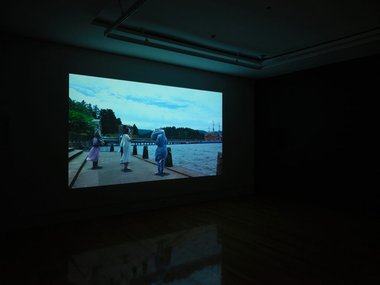


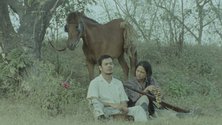
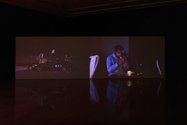

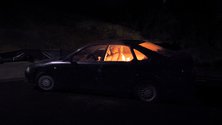
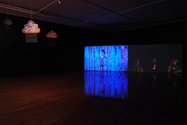



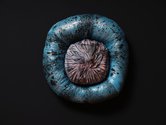
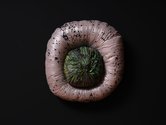

 Two Rooms presents a program of residencies and projects
Two Rooms presents a program of residencies and projects Advertising in this column
Advertising in this column



This Discussion has 0 comments.
Comment
Participate
Register to Participate.
Sign in
Sign in to an existing account.